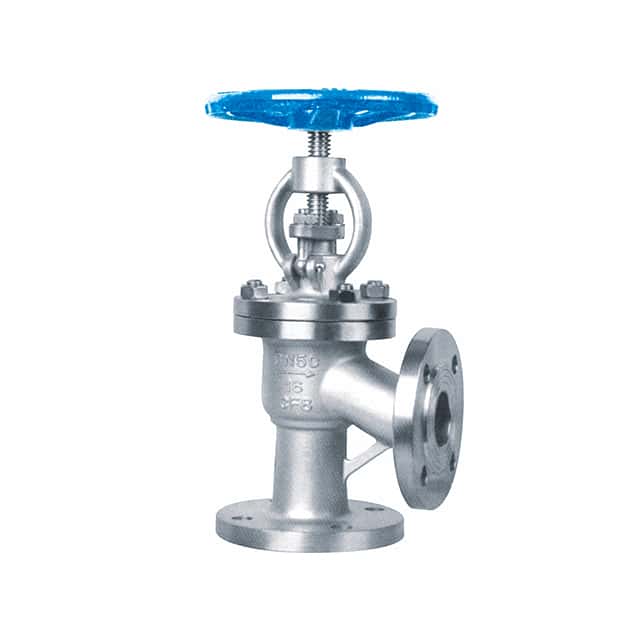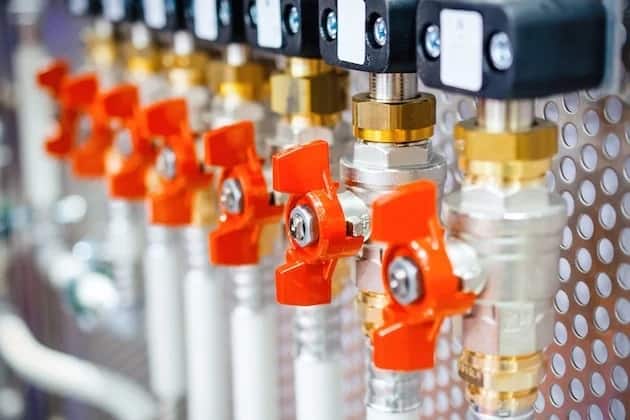What Is A Globe Valve:
Globe valves are closing-down valves with a linear motion closure member that moves squarely on and off the seat. Regardless of its shape, the closing member is usually called a disc.
The disc travel is proportional to the seat opening—this proportionate link between valve opening and disc motion works in a flow rate change. Globe valves are best for throttling and controlling fluid flow in small pipe systems.
The design of a globe valve needs two changes in the flow direction. This results in resistance in liquid lines and an unfavorable pressure reduction. When the globe valve is installed, the flow is directed up through the seat ring and against the bottom disc. This keeps dirt and debris from accumulating above the disc.
Globe valves are suitable for various tasks in fluid handling process piping systems. But, a globe valve works as a block or isolation valve. Its primary function is to control flow in half an open state. Because maintaining a tight seal against the strong force pressing up on the disc is challenging. Design selection is essential when considering globe valves for on-off isolation service. The globe valve has a shorter stem movement between open and closed positions and is easier to repair.
Principles of globe valve working:
The actual work of a globe valve is to stop, start, and regulate flow. A usually spherical body consists of a moveable disc and a stationary ring seat. A globe valve’s seat is in the middle of and parallels the pipe, and the disc closes the opening in the seat.
The valve stem lowers or raises a disc when the handle twists manually or with an actuator. The fluid flow is turned off after the disc is completely lowered. The fluid flow is at its highest when the disc is completely lifted. When the disc rises to a lower level, the fluid flow regulates the disc’s vertical journey.

Types of globe valve:
There are three significant types of globe valves.
- Y-type
- Z-type
- Angle type
y-type globe valve:
They-type valve rectifies the high-pressure loss problem related to the Z-shape valve. The Y valve’s stem and seat form a 45-degree angle. It provides a straight flow path with minimal flow resistance when completely expanded. It can stay open for a long time without sustaining significant erosion.
This valve is typically used for throttling during startup or seasonal operations. Garbage is usually removed from drain lines using Y-valves. It’s employed in services with a high head and those with pressure drop problems.
Z-type globe valve:

These globe valves have the most straightforward design. As a result, these valves are often used in the manufacturing business. The Z-type separation has a seat in the spherical body. The valve disc and stem move vertically to the pipe axis. The valve seat is seated, resulting in high-pressure drops. There are two sorts of valves: T-type and Z-type valves.
The seat is accessible from the hood. A large opening on the top connects this bonnet to the valve body. The stem acts as a gate valve through the bonnet. These globe valves have an enormous pressure loss and flow rate.
In closed throttling systems, Z-type valves are very helpful. These globe valves are ideal for applications that need throttling and do not require pressure loss.
Angle globe valve:
This globe valve is an upgraded version of the Z-type globe valve. These valves may change the flow direction by 90 degrees without extra pipe bends or welds. In the opposite direction of the flow, the disc opens. These water valves handle the slugging effects. They’re also suitable for use with varying flow rates. It has a somewhat lower flow coefficient than Y shut-off valves.

Applications of globe valve:
- Cooling water systems that need flow regulation
- A fuel oil system with a regulated flow focused on leak-tightness.
- When leak-tightness and safety are top priorities, use high-point vents and low-point drains.
- Feedwater, chemical feed, air extraction from the condenser, and extraction drain system
- Turbine seals and drains
- Turbine lube oil system and others

Ball valve:
A ball valve is a device that rotates a ball-shaped disc to control the flow of various substances. It’s open when the hole in the ball stands up with the flow entering. The valve closes when the handle is rotated 90 degrees, stopping the flow. When the valve is open, the handle becomes parallel to the flow. Here When it’s close, it’s still perpendicular to it.
This allows for easy visual validation of the valve’s condition. In closed settings, the 1/4 turn has two functions. It is possible in two ways clockwise or counterclockwise. These valves have a long lifespan. To turn it on or off, a slight motion is required. They have a lengthy lifespan.
How ball valve work:
Multiple ports, or apertures in the valve, are possible with ball valves. Two-way ball valves are often used for classic on/off control and have two ports. Multi-port valves are used in applications that need more than one media source.
A ball valve’s port can be manually or automatically opened or closed to control media flow. You’ll need handles or levers and an operator to control the valve manually. The valve can be maintained without an operator using electric(motorized) manual using pneumatic actuation. Actuation is appropriate for complex control systems or those located in difficult-to-reach locations.
Ever found yourself amidst the vast spectrum of plumbing solutions and wondered about the significance of each component? Why is one valve preferred over another in different scenarios? Amidst these components, the ball valve often emerges as a preferred choice for many. But what makes it so special?
Ball valves are pivotal components in plumbing systems, standing out for their simplistic yet effective design. They play a crucial role in controlling and shutting off the flow of liquids or gases in a system, attributing to their wide application across various sectors.
Keeping readers engaged in the world of valves might seem tricky. Yet, the ball valve, with its unique mechanism and broad usability, surely keeps us on our toes, eager to delve deeper.
Why is the Structure of a Ball Valve Unique?
Ball valves consist of a spherical disc with a hole in between, acting as a passage for the fluid. When the valve is open, the hole aligns with the pipeline, allowing fluid to flow through. When closed, the hole is perpendicular to the pipeline, blocking the flow.
What Materials Are Commonly Used in Ball Valves?
The choice of material can significantly affect the performance and lifespan of ball valves. Common materials include stainless steel, brass, and PVC, each catering to different operational requirements and environmental conditions.
Why Choose a Ball Valve Over Other Valves?
Ball valves are known for their excellent sealing and low-pressure drop, making them an ideal choice for many applications, including gas, water, and other fluid control systems. Their simple operation also ensures reliability and minimal maintenance, proving cost-effective in the long run.
What Are the Typical Sizes and Pressure Ratings of Ball Valves?
Sizes of ball valves range from 0.2 inches to 11.8 inches, while the pressure ratings can vary from 150 to 2500 pounds per square inch (psi). The variety in size and pressure ratings makes ball valves adaptable to both small-scale residential and large-scale industrial applications.
What Are the Different Types of Ball Valves?
Delving into the different types, one can encounter full port, reduced port, V-port, and trunnion ball valves. Each type serves a distinct purpose, varying in flow control capabilities and structural design.
What Makes Ball Valves a Preferred Choice in Many Industries?
The high durability, easy operation, and tight sealing capabilities make ball valves a popular choice across many industrial sectors. Their ability to work efficiently under varying temperatures and pressures further escalates their demand.
How Does a Ball Valve Contribute to the Efficiency of a System?
The quick opening and closing mechanism of ball valves enhances system efficiency by ensuring precise control and minimal leakage. Their robust design also contributes to longer system life and reduced maintenance needs.
Ball valves embody a blend of simplicity and efficiency, making them an indispensable component in modern plumbing and industrial applications. Their widespread popularity stems from their reliable operation, durable construction, and adaptability to different operational needs, affirming their position in the realm of fluid control solutions.
Applications of ball valve:
Ball valves are used in every aspect of our life. Following are some of the prominent applications.
- Washing machine
- Outdoor hoses
- Dishwashers
- Vehicle wash system
- Biopharma industry
- Oil and gas
- Food and beverages

Globe valve versus ball valve :
The primary distinction between a globe and a ball valve is opening and closing the flow. A globe valve controls and throttles the flow, but a ball valve does not control the flow and only closes it. It can regulate the flow with a globe valve. Ball valves are well-suited to shutting the flow without causing any pressure drops.
Another distinction is that a ball valve has a rotating stem and ball horizontally. In contrast, a globe valve has a vertically moving stem and plug. The ball valve keeps the flow closed for an extended period. In high-pressure systems like fire hoses, a ball valve is more efficient.
If flow regulation is the concern, using a globe valve is advisable. Globe valves are significant in cooling systems and other applications. Ball valves, unlike globe valves, have no installation limits. Furthermore, when compared to globe valves, ball valves are lighter.
Ball valves are also more durable and perform well after many cycles. They are more reliable even after a lengthy period of misuse. Ball valves have a modest obstruction of their fluid and are thus quieter. Still, globe valves have a significant fluid block and may become noisy after many years of operation.
